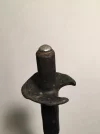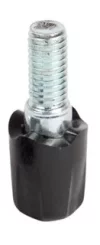@MichaelSG, I take a quite different view about this. The design of the tip, with its screw in thread, is just one of the design compromises BD made to keep the z-poles extremely light. I recall the company making much of its discussions with the climbing fraternity in particular in reaching this design. They were a pole designed for a niche market segment, not the broader walking market, even though they are now widely sold across the board.
So what are the design compromises here:
- first, the tips cannot easily replaced without other tools. Some of the weight reduction of the poles is offset by the need to carry a small pair of pliers or a multi-tool. If one already does that, it won't be seen as significant, but it is still there.
- second, If you need to change tips from the carbon tip to a rubber tip regularly, you cannot do this while walking. I can do this with a conventional rubber tip that slides onto the end of the pole and covers the metal tip. I do it regularly on my walks as I move from a soil surface where I want to reduce the penetration effect of the bare metal tip, and other surfaces where I want to ensure that the pole tip does not slip.
- third, the diameter of the pole tip is quite thin - too thin for the company's own regular rubber tips to be securely fitted to the pole. I might cynically suggest that this might have been a deliberate approach to increasing the sales of the specialized screw style tips rather than give their customers the choice of the somewhat cheaper regular tips. Even if it were an oversight rather than a deliberate marketing ploy, it ensures that only BD products can be used as replacement parts. Note that I have already suggested a way of using a regular pole tip (see the link in my earlier post).
- fourth, again on the matter of the diameter of the pole tip, when in use, the rubber tip does not have sufficient contact area to prevent significant penetration into soft soils, increasing the damage that might be done to the environment compared to the regular rubber tips.
- fifth, because regular pole tips cannot be used without some form of modification, these poles cannot, for example, be fitted with the walking style tip that I use in urban areas so that I can use my poles as an adjunct to my training regime.
- sixth, when a regular rubber tips wears out, it merely exposes the underlying metal tip, which then might face additional wear but does not damage the tip itself. As you rightly point out, when the z-poles rubber tip wears out, the exposed metal will wear quickly to the point where it is difficult to replace with normal tools, require specialist tools to remove the remaining stump of the top, and may damage the remaining part of the tip in the process.
These are issues just with the tip. There are other issues with the design that I don't need to go into here. Whether you think of them as flaws or compromises is not the issue here. Expecting owners to address just one of these compromises might have been acceptable, but taken together they present a strong argument that these are not particularly good poles for regular, long distance walking.
























